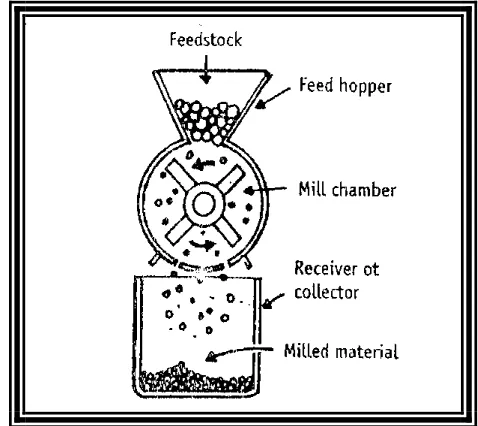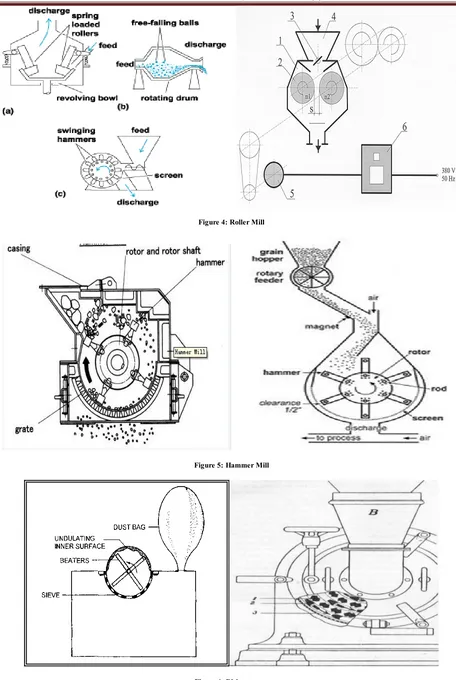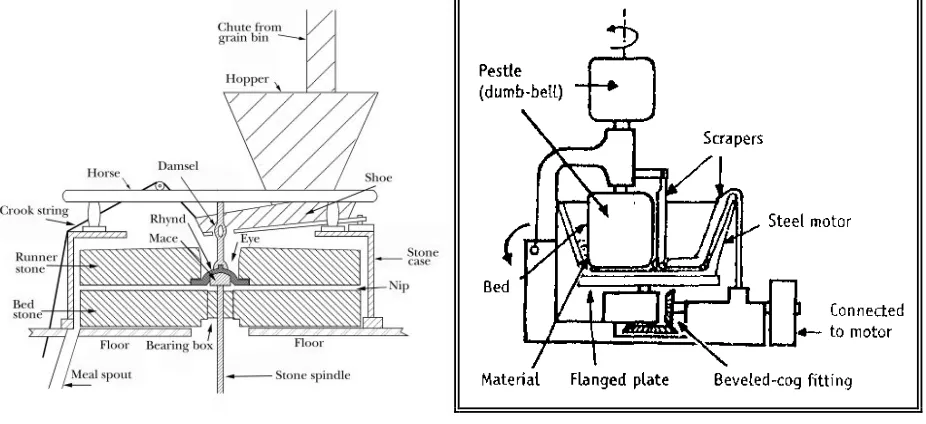METHODS OF SIZE REDUCTION AND FACTORS AFFECTING SIZE REDUCTION IN PHARMACEUTICS
Full text
(2) Sud Sushant et al. Int. Res. J. Pharm. 2013, 4 (8) Methodology Mechanism of Size Reduction Highlighted in Table 1 and Figure 2 Classification and Characteristic of Size Reduction Equipments Highlighted in Table 2 An Over-view on Various Size Reduction Equipments In order to understand the concept of size reduction, it is necessary to enumerate different instruments with their principle, parts and uses; they are as follows7,8 Rotary Cutter Mill Principle Size Reduction involves successive cutting / Shearing the feed material with help of sharp knife. Highlighted in Figure 3 Parts · Hopper · Milling chamber- Horizontally mounted rotor disc consisting 2 to 12 rotating knives spaced uniformly and Casing has stationary knives · Screen · Discharge chute Determination of Particle Size and Shape · Rotor size · Gap between the 2 sets of knives · Sieve Uses · Size reduction of tough - fibrous materials · Medicinal plants, animal tissues are converted to small parts Variants · Double runner disc mill · Single runner disc mill Roller Mill Principle Material is compressed by application of stress and attrition. Stress is applied by rotating heavy wheels, Muller or Rollers. Highlighted in Figure 4 Parts 2 cylindrical rollers of stone / metal – mounted horizontally, having diameter ranging from few millimetres to a meter. They rotate in longitudinal axis; one roller is run by motor and other freely. Determination of Particle Size and Shape Gap between rollers controlled to obtain desired particle size Uses For crushing of seeds before extraction of fixed oils. Variants · Multiple / corrugated rollers · Ribbed / saw-toothed rollers Hammer Mill Principle It operates on the principle of impact between rapidly moving hammers mounted on rotor and the stationary powder material. Highlighted in Figure 5 Parts Consists of a stout metal casing, enclosing a central shaft, to which 4 or more swinging hammers are attached. Lower part. of casing consists of a screen, through which material can pass and collected in a suitable receiver. Determination of Particle Size and Shape · Rotor speed · Feed rate · Clearance between hammers and grinding plates · Size of discharging opening Uses · Brittle material is best fractured by impact from blunt hammers. · Fibrous material is best reduced by cutting edges Variants · Fitzpatrick comminuting machine - Fitz mill · Stokes Tornado mill Disintegrator Principle The size reduction is done by impact. Highlighted in Figure 6 Parts Consists of a steel drum enclosing a central shaft, which has a disc to which 4 beaters are fixed. The side and upper inner surface of drum is rough. Lower part of casing consists of a detachable screen. Uses To powder all types of drugs including very hard drugs. Ball Mill Principle It operates on the principle of impact and attrition. Highlighted in Figure 7 Parts · Consists of a hollow cylinder mounted on a metallic frame such that it can be rotated along its longitudinal axis. · Cylinder contains balls occupying 30–50 % of mill volume. Weight of ball is constant; Size depends on the feed quantity and diameter of mill. Determination of Particle Size and Shape · Size of ball · Feed rate · Speed of rotation of cylinder Uses Produces fine powder, Can grind large variety of materials. As it is a closed system Toxic substances can be ground. Fluid Energy Mill Principle It operates on the principle of impact and attrition. Highlighted in Figure 8 Parts · Consists of a loop of pipe with diameter 20-200 mm. The overall height of the pipe is 2 m. · Inlet for feed and a series of nozzles for air, inert gas. Outlet with classifier which prevents the particles to pass until they become sufficiently fine. Determination of Particle Size and Shape · The speed of air / inert gas · The impact between the feed and air Uses To grind heat sensitive materials.. Page 58.
(3) Sud Sushant et al. Int. Res. J. Pharm. 2013, 4 (8) End- Runner and Edge- Runner Mill (Highlighted in Figure 9 and 10) Other Important Techniques in Size Reduction · Sono-crystallization - Utilizes ultra sound of frequency range 20 – 100 kHz for inducing crystallization. It is a effective means of size reduction and controls size distribution of active pharmaceutical ingredients.9 · Spray drying - It is a common method of drying a liquid feed through a hot gas. This hot gas is air, but sensitive materials such as such as ethanol require oxygen free drying and nitrogen gas.9 · Supercritical fluid process - It is a dense non-condensable fluid whose temperature and pressure are greater than its critical temperature and critical pressure. Drug particles are solubilised within super critical fluids and recrystallized to get greatly reduced particle sizes.9 Advantages of Size Reduction · Content uniformity · Uniform flow · Effective extraction of drug · Effective drying · Improves physical stability. The rate of sedimentation decreases by reducing particle size · Improves dissolution rate · Improves rate of absorption. Smaller the particle, greater is the absorption. · Increases surface area and viscosity · Facilitates bioavailability, uniform mixing and drying Disadvantages of Size Reduction · Drug degradation · Poor Mixing · Contamination Factors affecting Size Reduction Selection of mill - It is related to feed, milled product, safety and economics.9,10 Factors related to nature of raw materials affecting size reduction · Hardness - It is easier to break soft material than hard materials. Ex: For iodine hammer mill is used. · Fibrous - These are tough in nature. A soft, tough material has more difficulty than a hard, brittle substance. Ex: Rauwlfia, Ginger. Here cutters can be used. · Friable- These tend to fracture along well defined planes. Brittle substances can be easily converted into fine particles. Ex: Sucrose. Mechanism used is attrition, impact and pressure. · Elastic / Sticky - Become soft during milling. Ex: synthetic gums, waxes, resins. Low melting substances should be chilled before milling. These are milled using hammer, colloid or fluid energy mill. · Melting point - Waxy substances, fats and oils are softened during size reduction due to heat generated. This is avoided by cooling the mill and the substance. · Hygroscopic - Certain substances absorb moisture content rapidly. This wet mass hampers the milling process. Ex: Potassium carbonate. Closed system such as porcelain ball mill is used.. · Solvated- Hydrates liberate water during milling, causes clogging of mill. Ex: sodium sulphate. · Thermolability- Certain Substances are degraded by hydrolysis and oxidation, due to moisture and atmospheric oxygen. Heat produced on milling enhances these reactions. Closed system is used here with an inert atmosphere of CO2 and N. Vitamins and antibiotics are milled using fluid energy and ball mills.10,11 Other Factors affecting size reduction · Purity required - The size reduction of such hard substances leads to the abrasive wear of milling parts, causing contamination. Such mills are to be avoided. The mills should be thoroughly cleansed between different batches. · Flammability - Under certain conditions fine dust such as dextrin, starch, sulphur are potential explosive mixtures. All electrical switches should be explosive proof and mill should be well grounded · Particle size - The feed should be of proper size and enter the equipment at a uniform rate to get a fine powder. Several stages are carried out in size reduction process. Pre treatment of fibrous materials with pressure rollers and cutters facilitates further Comminution. · Moisture content- Presence of more than 5 % moisture influences hardness, toughness, stickiness of substance. In general, materials with moisture content below 5 % are suitable for dry grinding and above 50 % for wet grinding.10,11 Advances in Size Reduction Technologies · Micron technologies - Micronizing is defined as particles smaller than 20 microns. It enhances solubility and improves bioavailability, optimizes the formulation of the product and reduces therapeutic dose. High pressure air / gas are introduced causing particle collision and micronization. · Gran-U-Lizer Technology - It is designed to maximize yield and minimize the size of particles. In this process there is regrinding of already ground particle, resulting in very tight particle size. · Jet-O-Mizer particle size reduction - This mill is designed with distinct features to consume less power, provide greater range of output and ensures exceptional finished product quality. It is efficient in fine grinding and classification, no attritional heat, adjustable classification zone. · Micro fluidizer particle size reduction - The ultra-high shear developed by the micro fluidizer processor reduces the particle size and high turbulence prevents agglomeration. This method produces a very stable product with long shelf life.12-14 DISCUSSION The size reduction sector in pharmaceutics is so complex and extensive that only a brief overview of the most important size reduction methods can be given here. Ever-new applications from the research and development divisions of different target markets lead to the continual further development of size reduction machines and grinding tools.15 There are many types of size-reduction equipment, which are often developed empirically to handle specific materials and then are applied in other situations. Knowing the properties of the material to be processed is essential. Page 59.
(4) Sud Sushant et al. Int. Res. J. Pharm. 2013, 4 (8). Figure 1: General Parts of Size Reduction Equipment (Three basic Components). Figure 2: Mechanism of Size Reduction. Figure 3: Rotary Cutter Mill. Page 60.
(5) Sud Sushant et al. Int. Res. J. Pharm. 2013, 4 (8). Figure 4: Roller Mill. Figure 5: Hammer Mill. Figure 6: Disintegrator. Page 61.
(6) Sud Sushant et al. Int. Res. J. Pharm. 2013, 4 (8). Figure 7: Ball Mill. Figure 8: Fluid Energy Mill. Figure 9: Edge Runner Mill. Page 62.
(7) Sud Sushant et al. Int. Res. J. Pharm. 2013, 4 (8). Figure 10: End Runner Mill Table 1: Mechanism of Size Reduction-Methodology Methods Cutting Compression Impact Attrition Combined Impact and Attrition. Examples Scissors Shears Cutter Mill Roller Mill Pestle-Mortar Hammer Mill Disintegrator Colloidal Mill Roller Mill Ball Mill Fluid Energy Mill. Approx. particle size (µm) 100-80,000 50-10,000 50-8000 1-50 1-2000. Table 2: Classification and Characteristic of Size Reduction Equipments Equipments Cutter Mill Impact Mill (Hammer Mill) Rolling Compression (Roller Mill) Attrition Mill Tumbling Mill Fluid Energy Mill Edge Runner Mill End Runner Mill. Techniques Cutting Machine. Uses. Ultra Fine Grinders. Used for almost all the drugs Soft materials Used for almost all the drugs Brittle drugs --------- do --------Moderately hard and friable materials. Crushers. Soft materials. Grinders. Probably the most important characteristic governing size reduction is hardness because almost all size-reduction techniques involve somehow creating new surface area and this requires adding energy proportional to the bonds holding the feed particles together. Nearly all size-reduction techniques result in some degree of fines. So unless producing very fine particles is the objective, it usually is more efficient to perform size reduction in stages, with removal of the desired product after each operation.16 CONCLUSION The chemical, pharmaceutical, food and mining industries all rely on size reduction. Size reduction technology has considerable importance in the pharmaceutical field. Size reduction technology has application in different fields like pharmaceutical manufacturing of novel and conventional dosage forms, supercritical fluid technology, drug delivery, nanotechnology, etc. It offers several advantages such as content uniformity, uniform flow, facilitates mixing etc. The. final selection of the equipment is based on the material and the quality requirements of the product. REFERENCES 1. Patel Rakesh P, Ashok H Baria and Nikunjana A Patel. An Overview of Size Reduction Technologies in the Field of Pharmaceutical Manufacturing - Asian J Pharm. Asian Journal of Pharmaceutics (AJP) 2008. Web. 20 Nov. 2011. http://www.asiapharmaceutics.info /article.asp?issn=09738398;year=2008;volume=2;issue=4;spage=216; epage=220;aulast=Patel 2. Price M. Size reduction. In: Othmer K, editor. Encyclopaedia of chemical technology. New York: John Wiley and Sons; 1999. p. 8368. 3. MacDonald LH and Himelick RE. J. Am. Pharm. Assoc., Sci. Ed 1948; 37: 368. 4. Shekunov Boris Y, Pratibhash Chattopadhyay, Henry HY Tong and Albert HL Chow. Particle Size Analysis in Pharmaceutics: Principles, Methods and Applications. Pharmaceutical Research 2007; 24.2: 20327. http://dx.doi.org/10.1007/s11095-006-9146-7 PMid:17191094 5. Snow RH, Kaye BH, Capes CE, Srety GC. Size reduction and size enlargement. In: Perry RH, Green D, editors. Chemical Engineers Handbook. McGraw Hill International; 1963. p. 1-72. PMid:14068170 6. Connor RE, Schwartz JB, Powder. In: Gennaro AR, editor. Remington: The science and practice of pharmacy. USA: Lippincott Williams and Wilkins; 2001. p. 681-99.. Page 63.
(8) Sud Sushant et al. Int. Res. J. Pharm. 2013, 4 (8) 7. 8. 9. 10. 11.. 12.. Robert EOC, Powders, Remington: The science and practice of pharmacy, Vol.2; 19th ed Mack publishing company; 1995. p. 1609. Kakumanu VK, Bansal AK. Supercritical fluid technology in pharmaceutical research. Business briefing: Labtech; 2004. p. 71-3. Ahmad M. Abdul Fattah, Hridaya N. Bhargava. Int J Pharm 2002; 1723. Banga S, Chawla G, Bansal AK. New trends in the crystallisation of active pharmaceutical ingredients, Business briefing. Pharmagenerics 2004; 6: 70-4. Chattopadhyay P, Gupta RB. Protein nanoparticles formation by supercritical antisolvent with enhanced mass transfer. Am Inst Chem Eng J (AIChE) 2002; 48:235-44. http://dx.doi.org/10.1002/ aic.690480207 Micronization, Micron Technologies, Kent United Kingdom. Available from: http://www.microntech.com/micron/index.html. 13. 14. 15. 16.. Gran U Lizer™ Technology, Modern Process Equipment Corporation, Chicago, llinois 60623 U.S.A. Available from: http://www. mpechicago.com/pharm Jet O Mizer™ Technology, Fluid Energy Processing and Equipment Company, Telford, PA 18969. Available from: http://www.fluid energype.com/lit.htm http://www.retsch.dk/pdf/pdf_applikationer/size_reduction_basics.pdf http://www.chemicalprocessing.com/articles/2005/399. Cite this article as: Sud Sushant, Kamath Archana. Methods of size reduction and factors affecting size reduction in pharmaceutics. Int. Res. J. Pharm. 2013; 4(8):5764 http://dx.doi.org/10.7897/2230-8407.04810. Page 64.
(9)
Figure



Related documents
This paper identifies and analyzes factors that are vital to cause disaster in an e-commerce firm, based on the recent disasters studied.. To study and analyze of eight
We load policies into the hypervisor dynamically at runtime to avoid perfor- mance penalty caused by context switches between the hypervisor and the man- agement domain. We use
This means that service quality has a positive effect on customer loyalty.Service Quality positively affects customer loyalty, meaning the better the quality of
Existing guidelines for screening Guidelines from the American College of Cardiology/American Heart Association (ACC/AHA) and the American Diabetes Association (ADA) recommend
ing and interface dynamics on tool point FRF for chatter stability in machine tools by using a new analytical model for spindle – tool as- semblies,” Int. of Machine Tools
commercial litigation; products liability defense; insurance defense of first and third party claims) Barber Law Firm, LLP; Little Rock, Arkansas. John Everett (General
Social roles have been found to be an essential aspect of morality which is more than just a static concept (Harper, 2009). Once an individual accepts that radical Islam is the
Seventy BALB/c mice were divided into five experimental groups (14 mice per group) including 1- control (received PBS), 2- vaccine (immunized with F. hepatica E/S antigens),